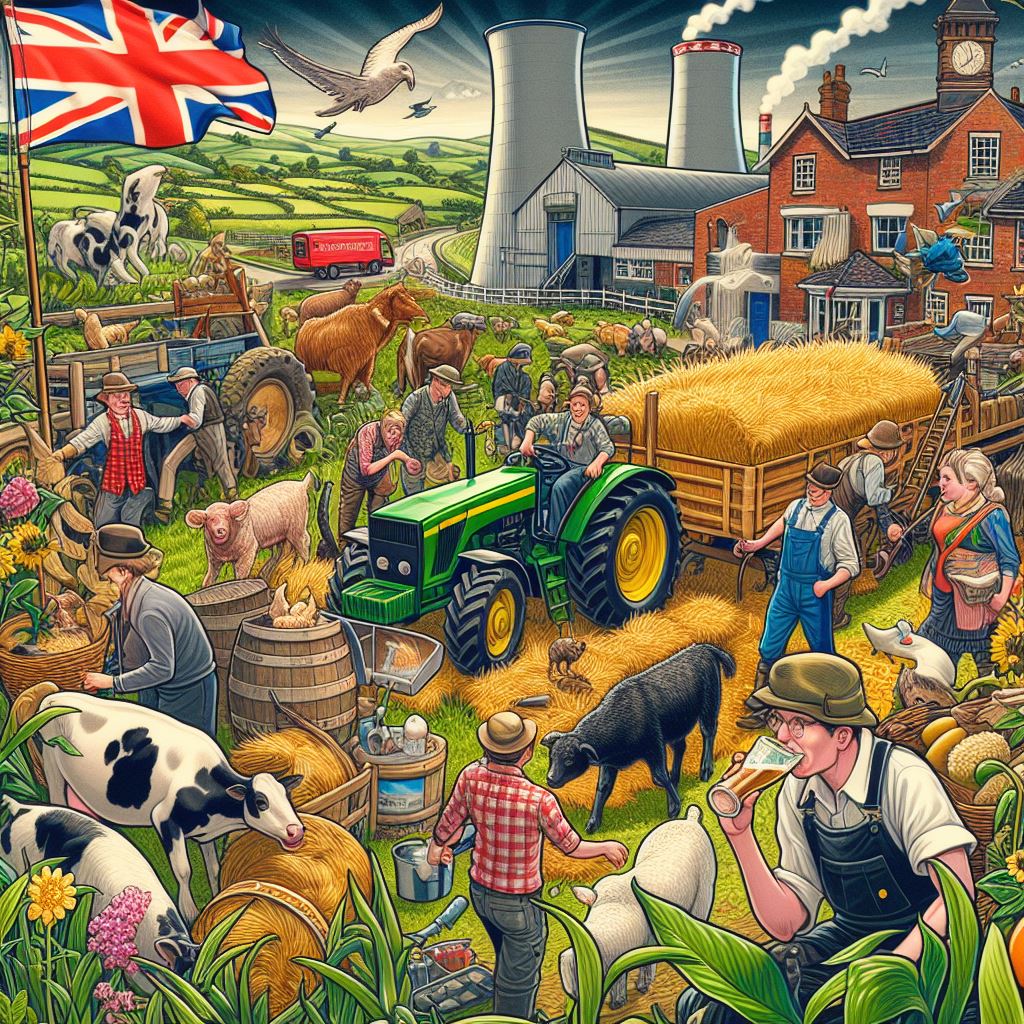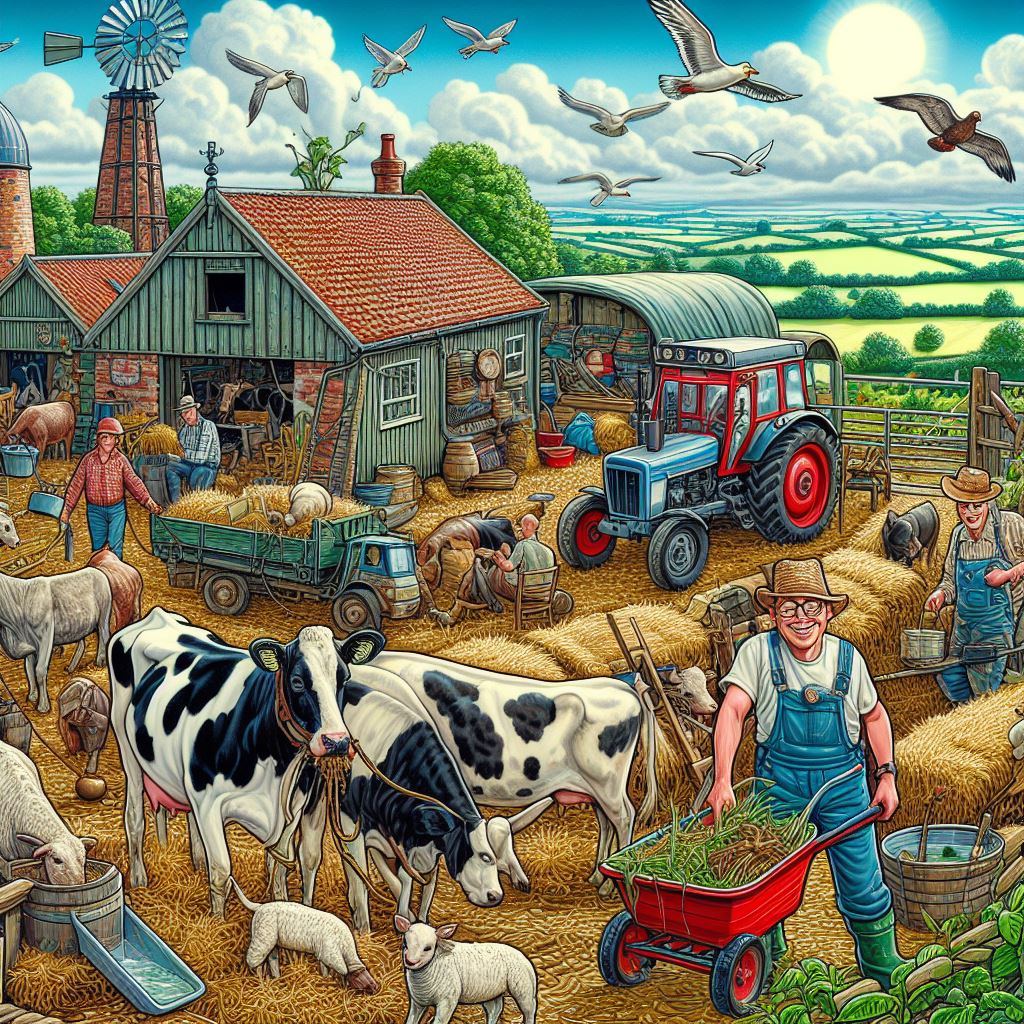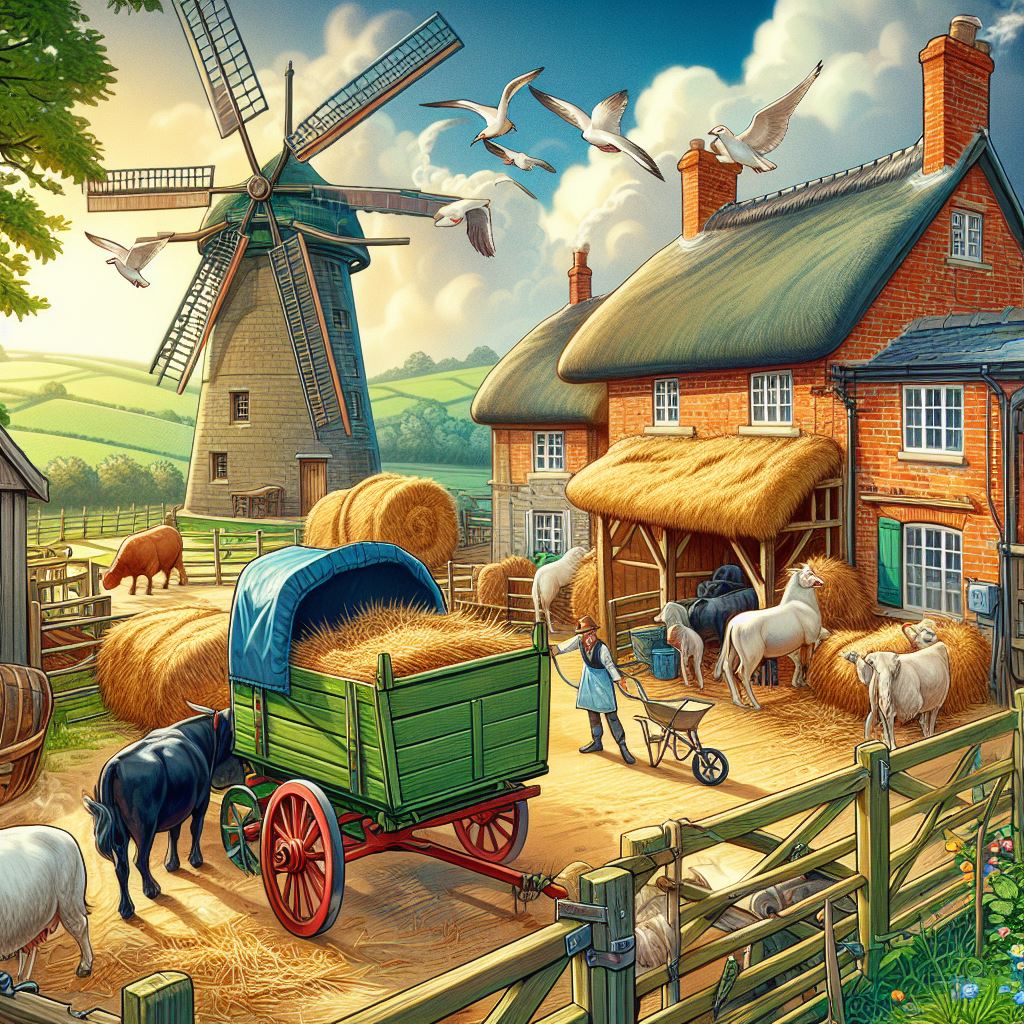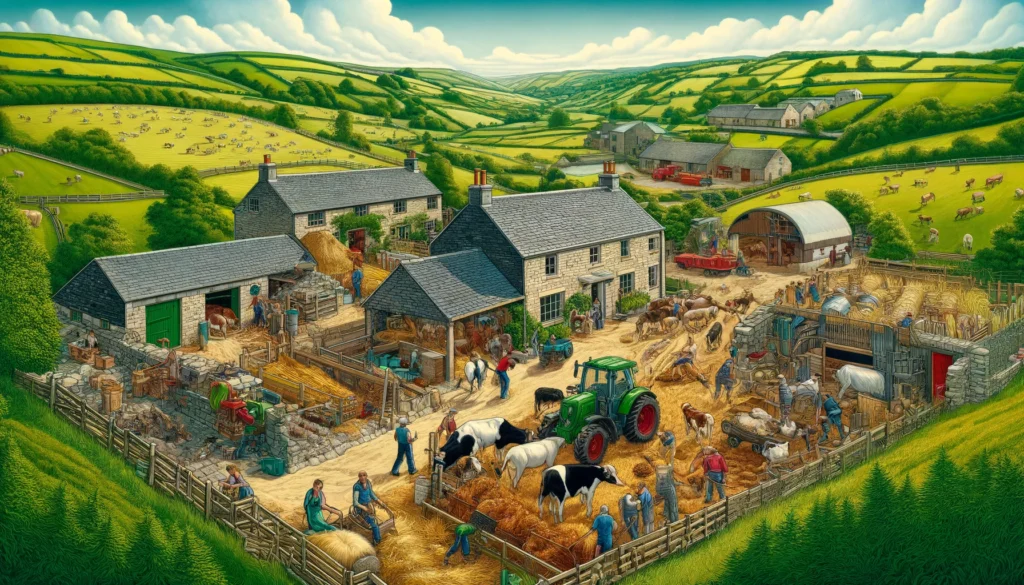The Rich and Diverse Farm Culture in the UK
The United Kingdom has a rich and diverse agricultural heritage that plays a vital role in the nation’s economy, environment, and social fabric. Farm culture in the UK encompasses traditional farming practices, contemporary innovations, community involvement, and a deep respect for the land and its produce. This comprehensive guide explores the various aspects of farm culture in the UK, offering insights, practical tips, and historical perspectives to enhance understanding and appreciation of this important sector.
Historical Overview of UK Farming
Ancient and Medieval Agriculture
- Prehistoric Farming: Early settlers in the UK practiced basic forms of agriculture, including crop cultivation and animal husbandry, which laid the foundation for modern farming.
- Roman Influence: The Roman occupation introduced advanced agricultural techniques, including crop rotation, irrigation, and the use of plows.
- Medieval Feudal System: The feudal system structured medieval agriculture, with large estates managed by lords and worked by peasants. Open field systems and communal farming were common practices.
Agricultural Revolution
- 17th-18th Centuries: The Agricultural Revolution brought significant changes to UK farming, including the enclosure movement, which privatized common lands, and innovations like the seed drill and selective breeding.
- Crop Rotation: The adoption of the four-field crop rotation system (wheat, turnips, barley, and clover) improved soil fertility and increased yields.
- Mechanization: The introduction of machinery, such as the threshing machine, further enhanced agricultural productivity.
Modern Agriculture
- 20th Century: The 20th century saw continued mechanization, the rise of chemical fertilizers and pesticides, and the development of high-yield crop varieties.
- Post-War Changes: After World War II, government policies promoted agricultural intensification to ensure food security.
- Contemporary Trends: Today, UK farming embraces sustainable practices, organic farming, and technological advancements like precision agriculture.
Types of Farming in the UK
Arable Farming
- Crops Grown: Common arable crops include wheat, barley, oats, potatoes, and oilseed rape.
- Regions: Arable farming is prevalent in the eastern counties of England, such as Norfolk, Suffolk, and Lincolnshire.
- Practices: Techniques include crop rotation, conservation tillage, and the use of cover crops to maintain soil health.
Livestock Farming
- Dairy Farming: Dairy farms, particularly in the southwest and west of England, Wales, and Northern Ireland, produce milk, cheese, and other dairy products.
- Beef Farming: Beef cattle are raised across the UK, with notable breeds including Hereford, Angus, and Highland cattle.
- Sheep Farming: Sheep farming is prominent in upland areas like the Lake District, Scottish Highlands, and Wales, producing wool and lamb.
Mixed Farming
- Definition: Mixed farming combines crop production and livestock rearing on the same farm, allowing for diversified income and sustainable land use.
- Benefits: This approach improves soil fertility, reduces risk, and enhances biodiversity.
Horticulture
- Crops Grown: Horticulture includes the cultivation of fruits, vegetables, flowers, and ornamental plants.
- Regions: Key horticultural areas include Kent (known as the “Garden of England”), Herefordshire, and the Vale of Evesham.
- Practices: Techniques include greenhouse farming, hydroponics, and organic practices.
Organic Farming
- Principles: Organic farming avoids synthetic fertilizers and pesticides, emphasizing natural processes and inputs.
- Certification: Farms must adhere to standards set by certification bodies like the Soil Association.
- Benefits: Organic farming promotes soil health, biodiversity, and environmental sustainability.
Cultural Practices and Traditions
Seasonal Celebrations
- Harvest Festival: Celebrated in autumn, the Harvest Festival is a time to give thanks for the year’s crops. It includes church services, feasts, and community events.
- Lambing Season: In spring, lambing season is a busy and joyous time on sheep farms, with community involvement and educational activities.
- Plough Monday: The first Monday after Epiphany, marking the return to work after Christmas, celebrated with traditional ploughing demonstrations and festivities.
Agricultural Shows
- Royal Highland Show: Held annually in Edinburgh, this event showcases livestock, crops, machinery, and rural crafts.
- Royal Welsh Show: A major event in Wales, featuring livestock competitions, agricultural displays, and cultural performances.
- Great Yorkshire Show: One of England’s largest agricultural shows, highlighting the best of farming, food, and rural life.
Traditional Farming Methods
- Hedgelaying: The ancient craft of hedgelaying involves partially cutting and bending shrubs to form a living fence, promoting biodiversity and landscape preservation.
- Dry Stone Walling: This technique involves building walls without mortar, commonly seen in upland areas like the Yorkshire Dales and the Cotswolds.
- Shepherding: Traditional shepherding practices, including the use of sheepdogs, are integral to sheep farming culture in the UK.
Community and Social Aspects
Farm Families and Generational Knowledge
- Family Farms: Many UK farms are family-owned and operated, with knowledge and traditions passed down through generations.
- Succession Planning: Ensuring the continuation of family farms involves careful planning and mentoring the next generation of farmers.
Rural Communities
- Community Support: Rural communities often support each other through cooperative initiatives, farmers’ markets, and local food networks.
- Social Events: Events like barn dances, fairs, and local festivals strengthen community bonds and celebrate farming culture.
Education and Training
- Agricultural Colleges: Institutions like Harper Adams University and the Royal Agricultural University offer specialized training and degrees in agriculture.
- Apprenticeships: Apprenticeship programs provide hands-on experience and training for young people entering the farming industry.
- Workshops and Courses: Various organizations offer workshops and courses on topics like sustainable farming, animal husbandry, and farm management.
Sustainable Farming Practices
Soil Health and Management
- Crop Rotation: Rotating crops to prevent soil depletion, reduce pest and disease buildup, and improve soil fertility.
- Cover Cropping: Planting cover crops to protect soil from erosion, improve soil structure, and enhance nutrient cycling.
- Reduced Tillage: Minimizing soil disturbance to maintain soil structure, reduce erosion, and enhance microbial activity.
Water Conservation
- Efficient Irrigation: Using drip or micro-sprinkler irrigation systems to reduce water use and ensure precise water delivery to crops.
- Rainwater Harvesting: Collecting and storing rainwater for irrigation and other farm uses.
- Mulching: Applying mulch to retain soil moisture, reduce evaporation, and suppress weeds.
Integrated Pest Management (IPM)
- Biological Controls: Utilizing natural predators and beneficial insects to control pest populations.
- Cultural Practices: Implementing crop rotation, intercropping, and planting resistant varieties to manage pests and diseases.
- Mechanical Controls: Using physical methods like traps, barriers, and hand-picking to reduce pest numbers.
Biodiversity Enhancement
- Agroforestry: Integrating trees and shrubs into agricultural landscapes to enhance biodiversity, improve soil health, and provide additional income sources.
- Hedgerows and Buffer Strips: Planting hedgerows and buffer strips to provide habitat for wildlife, reduce erosion, and capture runoff.
- Polyculture: Growing multiple crops in the same space to promote biodiversity and resilience to pests and diseases.
Renewable Energy
- Solar Power: Installing solar panels to generate electricity for farm operations, reducing reliance on fossil fuels.
- Wind Turbines: Using small wind turbines to harness wind energy, providing an additional renewable energy source.
- Bioenergy: Converting agricultural waste into bioenergy through anaerobic digestion or biomass combustion.
Animal Welfare
- Humane Treatment: Ensuring that animals are treated humanely, with access to clean water, adequate food, and proper shelter.
- Pasture-Based Systems: Raising animals on pasture to allow natural behaviors and improve animal health and well-being.
- Health Management: Using preventative healthcare measures, such as vaccinations and parasite control, to maintain animal health.
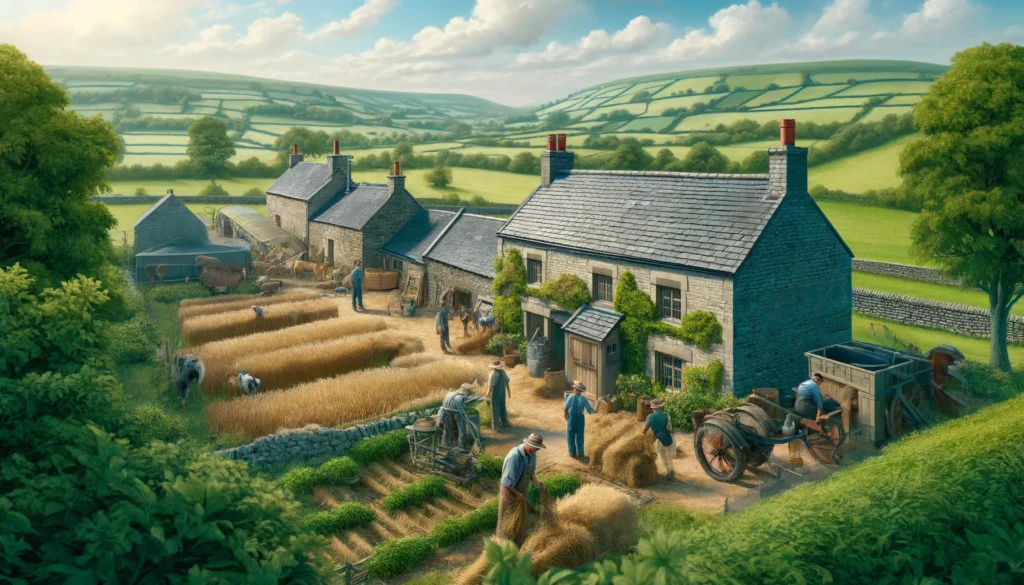
Technological Innovations in UK Farming
Precision Agriculture
- GPS and GIS Mapping: Using GPS and GIS technology to create detailed maps of fields, allowing for precise application of inputs.
- Variable Rate Technology (VRT): Utilizing VRT to apply fertilizers, pesticides, and irrigation at variable rates, optimizing resource use.
- Drones: Employing drones for aerial surveys to assess crop health, identify pest infestations, and monitor field conditions.
Smart Irrigation Systems
- Drip Irrigation: Implementing drip irrigation systems to deliver water directly to the root zone, reducing water waste.
- Automated Irrigation: Using automated irrigation systems controlled by soil moisture sensors and weather forecasts to ensure optimal watering schedules.
- Water Conservation Techniques: Employing mulching and cover cropping to retain soil moisture and reduce irrigation needs.
Data-Driven Decision Making
- Farm Management Software: Using farm management software to track inputs, monitor crop performance, and manage finances.
- Yield Mapping: Analyzing yield data to identify patterns and variations within fields, making adjustments to improve future yields.
- Weather Monitoring: Subscribing to advanced weather monitoring services to receive accurate forecasts and alerts, helping plan activities like planting and harvesting.
Renewable Energy
- Solar Power: Installing solar panels to generate electricity for farm operations, reducing reliance on fossil fuels.
- Wind Turbines: Using small wind turbines to harness wind energy, providing an additional renewable energy source.
- Bioenergy: Converting agricultural waste into bioenergy through anaerobic digestion or biomass combustion.
Challenges and Opportunities in UK Farming
Environmental Challenges
- Climate Change: Adapting to changing weather patterns and extreme weather events that impact crop yields and livestock health.
- Soil Degradation: Addressing soil erosion, compaction, and nutrient depletion to maintain soil health and productivity.
- Water Scarcity: Implementing water conservation practices to manage limited water resources.
Economic Challenges
- Market Volatility: Navigating fluctuating commodity prices and market demand for agricultural products.
- Cost of Inputs: Managing rising costs of inputs like feed, fertilizers, and fuel.
- Access to Finance: Securing funding and financial support for farm investments and sustainability initiatives.
Social Challenges
- Rural Depopulation: Addressing the decline in rural populations and the resulting impact on community vitality and labor availability.
- Aging Farmer Population: Encouraging young people to pursue careers in farming and supporting succession planning for family farms.
- Consumer Expectations: Meeting consumer demands for sustainable, ethically-produced food and transparency in farming practices.
Opportunities
- Sustainable Practices: Embracing sustainable farming practices to enhance environmental stewardship, improve resilience, and access premium markets.
- Technological Advancements: Leveraging technological innovations to improve efficiency, productivity, and resource management.
- Diversification: Exploring diversified income streams, such as value-added products, agri-tourism, and renewable energy generation.
Practical Tips for UK Farmers
Soil Health Management
- Regular Soil Testing: Conduct regular soil tests to monitor soil fertility and pH levels, and adjust management practices accordingly.
- Composting: Apply compost to improve soil fertility and structure, and increase organic matter content.
- Cover Cropping: Plant cover crops to protect soil from erosion, improve soil organic matter, and suppress weeds.
- Reduced Tillage: Minimize soil disturbance to maintain soil structure, reduce erosion, and enhance microbial activity.
Water Conservation
- Efficient Irrigation: Use efficient irrigation systems like drip or micro-sprinklers to reduce water use.
- Rainwater Harvesting: Collect and store rainwater for irrigation and other farm uses.
- Mulching: Apply mulch to retain soil moisture, reduce evaporation, and suppress weeds.
- Soil Moisture Monitoring: Use soil moisture sensors to optimize irrigation schedules and avoid overwatering.
Integrated Pest Management (IPM)
- Biological Controls: Use natural predators and beneficial insects to control pest populations.
- Cultural Practices: Implement crop rotation, intercropping, and resistant varieties to manage pests and diseases.
- Mechanical Controls: Use physical methods like traps, barriers, and hand-picking to reduce pest numbers.
- Chemical Controls: Apply pesticides as a last resort, using targeted applications to minimize environmental impact.
Biodiversity Enhancement
- Agroforestry: Integrate trees and shrubs into agricultural landscapes to enhance biodiversity, improve soil health, and provide additional income sources.
- Hedgerows and Buffer Strips: Plant hedgerows and buffer strips to provide habitat for wildlife, reduce erosion, and capture runoff.
- Polyculture: Grow multiple crops in the same space to promote biodiversity and resilience to pests and diseases.
- Wildlife Conservation: Create and maintain habitats for beneficial wildlife, including birds, bats, and pollinators.
Energy Efficiency
- Renewable Energy: Use renewable energy sources like solar, wind, and bioenergy to power farm operations.
- Energy-Efficient Equipment: Invest in energy-efficient machinery and appliances to reduce energy consumption and costs.
- Conservation Practices: Implement practices like no-till farming and cover cropping to reduce fuel use and greenhouse gas emissions.
Animal Welfare
- Humane Treatment: Ensure that animals are treated humanely, with access to clean water, adequate food, and proper shelter.
- Pasture-Based Systems: Raise animals on pasture to allow natural behaviors and improve animal health and well-being.
- Health Management: Use preventative healthcare measures, such as vaccinations and parasite control, to maintain animal health.
- Ethical Slaughter: Follow ethical guidelines for the humane slaughter of animals.
Future of Farming in the UK
Sustainable Intensification
- Definition: Sustainable intensification aims to increase agricultural productivity while reducing environmental impact.
- Practices: Incorporating practices like precision agriculture, integrated pest management, and resource-efficient technologies.
- Benefits: Achieving higher yields, improved resource use efficiency, and enhanced environmental sustainability.
Digital Agriculture
- Smart Farming Technologies: Adoption of smart farming technologies, such as IoT devices, sensors, and automation, to improve efficiency and decision-making.
- Data Analytics: Leveraging data analytics to optimize inputs, monitor crop health, and predict yields.
- Connectivity: Ensuring rural areas have access to high-speed internet to support digital agriculture innovations.
Climate-Smart Agriculture
- Climate Adaptation: Developing and implementing strategies to adapt to climate change impacts, such as changing planting dates and selecting climate-resilient crops.
- Carbon Sequestration: Enhancing carbon sequestration through practices like agroforestry, cover cropping, and reduced tillage.
- Water Management: Improving water management to cope with changing precipitation patterns and increased water scarcity.
Policy and Support
- Government Policies: Advocating for supportive government policies that promote sustainable farming practices, provide financial incentives, and protect farmers’ interests.
- Research and Innovation: Investing in agricultural research and innovation to develop new technologies and practices for sustainable farming.
- Education and Training: Providing education and training programs to equip farmers with the knowledge and skills needed for modern, sustainable agriculture.
Conclusion
Farm culture in the UK is a vibrant and integral part of the nation’s heritage, economy, and social fabric. By understanding the historical context, embracing sustainable practices, leveraging technological innovations, and addressing current challenges, UK farmers can ensure a prosperous and sustainable future for their farms and communities. This comprehensive guide offers valuable insights, practical tips, and strategies to support farmers in their journey toward sustainable and resilient farming practices. By fostering a culture of sustainability, innovation, and community, UK agriculture can continue to thrive and contribute to the well-being of the nation and the environment.
Farm Culture Image Gallery
